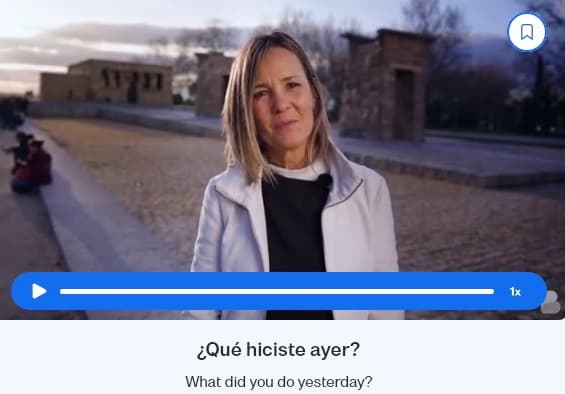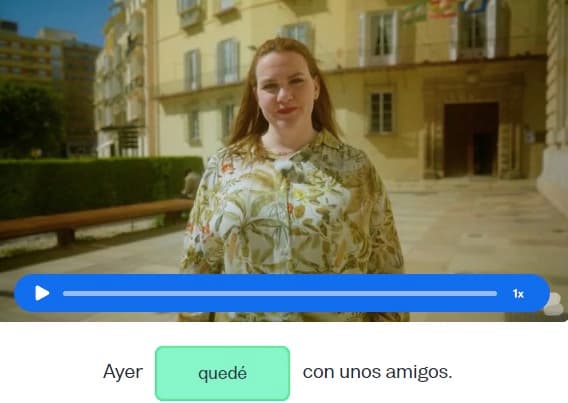I want to learn...
Knowing how to talk about things that happened in the past is an important part of any language, whether you are telling a story, providing context, or simply telling someone about your day. In Spanish, we can start doing this by learning Spanish past tense conjugations for the simple past ( pretérito indefinido).
While there are many different past tenses in Spanish, the simple past tense is used to describe actions that were completed or that ended in the past. We’ll take a look at the regular and some irregular verb conjugations for this tense along with how it is used with different expressions of time.
¿Listo? ¡Comencemos!
Ready? Let’s begin!
When to use the Spanish past tense
Before we jump into conjugations, it’s important to note how and when this verb tense is used.
While the present tense is used for describing general truths, habits, or actions that are happening at the time of speaking, the simple past is used to describe an action that was completed in the past.
Here is an example of a sentence in the present tense and one in the simple past, both using the verb hablar (to speak):
Yo hablo español todos los días. I speak Spanish every day. (simple present tense)
Yo hablé español ayer. I spoke Spanish yesterday. (simple past tense)
We can see from these examples that the simple present expresses something that happens regularly while the simple past talks about one specific action that occurred and finished in the past.
Now that we’ve seen its uses, let’s look at past tense conjugations in Spanish for regular verbs.
Spanish past tense conjugations: Regular verbs
Like in the present tense, there are different ways to conjugate regular verbs in the simple past tense depending on whether they end in -ar, -er, or -ir.
Luckily, -ir and-er verbs have same endings in this tense, so we’ll just use one table for both of those.
Let’s see what simple past tense conjugations look like.
Simple past tense Spanish conjugation: Regular -ar verbs
| Subject Pronoun | Verb Ending | Conjugation Example |
|---|---|---|
| yo | -é | hablé (I spoke) |
| tú | -aste | hablaste (you spoke) |
| usted | -ó | habló (you [formal] spoke) |
| él/ella | -ó | habló (he/she spoke) |
| nosotros/nosotras | -amos | hablamos (we spoke) |
| vosotros /vosotras | -asteis | hablasteis (you all spoke) |
| ustedes | -aron | hablaron (you all spoke) |
| ellos/ellas | -aron | hablaron (they spoke) |
Simple past tense Spanish conjugation: Regular-ir and-er verbs
| Subject Pronoun | Verb Ending | Conjugation Example |
|---|---|---|
| yo | -í | viví (I lived) |
| tú | -iste | viviste (you lived) |
| usted | -ió | vivió (you [formal] lived) |
| él/ella | -ió | vivió (he/she/you lived) |
| nosotros/nosotras | -imos | vivimos (we lived) |
| vosotros/vosotras | -isteis | vivisteis (you all lived) |
| ustedes | -ieron | vivieron (you all lived) |
| ellos/ellas | -ieron | vivieron (they lived) |
Note: Vosotros / vosotras is mainly used in Spain and not in Latin America, where they tend to use usted / ustedes instead. Check out our article on the differences in Spanish used in Spain and Latin America for more information.
Pretty straightforward, right? Here are some examples using each type of verb:
Él habló con su amigo por teléfono ayer. (He spoke with his friend on the phone yesterday.)
Tú viviste en España durante un año. (You lived in Spain for a year.)
Yo comí una deliciosa pizza anoche. (I ate a delicious pizza last night.)
These examples use the simple past and describe an action completed in the past. If you look closely, you’ll also see that these examples use different expressions of time, such as ayer (yesterday) oranoche (last night).
We’ll get to those expressions of time and how they are used with the simple past in just a second, but first, let’s look at some irregular verbs in the simple past.
Spanish past tense conjugations: Irregular verbs
Just like in the present tense, irregular verbs have special conjugation patterns in the simple past tense. Some commonly used irregular verbs include ser (to be), estar (to be), hacer (to do/make), and ir (to go).
Let’s learn those conjugations now.
Past tense Spanish conjugation: Irregular verbs ser, estar, hacer, and ir
| Subject Pronoun | Ser (to be) | Estar (to be) | Hacer (to do/make) | Ir (to go) |
|---|---|---|---|---|
| yo | fui | estuve | hice | fui |
| tú | fuiste | estuviste | fuiste | |
| usted | fue | estuvo | hizo | fue |
| él/ella | fue | estuvo | hizo | fue |
| nosotros/nosotras | fuimos | estuvimos | hicimos | fuimos |
| vosotros/vosotras | fuisteis | estuvisteis | hicisteis | fuisteis |
| ustedes | fueron | estuvieron | hicieron | fueron |
| ellos/ellas | fueron | estuvieron | hicieron | fueron |
Don’t worry - you’re not crazy: ser (to be) and ir (to go) do have the same simple past verb forms.
So you don’t confuse them, make sure you consider the context and meaning of the sentences in which they are used. When speaking, make sure that you add enough supporting words and phrases so the listener can understand properly.
Here are some examples using ser (to be) and ir (to go) in the simple past using context to help distinguish between them:
María fue mi novia hace unos años. (María was my girlfriend a few years ago.)
Él fue al cine con sus amigos anoche. (He went to the movies with his friends last night.)
What do you think - can you identify which sentence uses ser (to be) and which uses ir (to go)?
The first sentence uses ser (to be), and we know this because the speaker is talking about a relationship with another person.
Meanwhile, the second sentence uses ir (to go), and we can tell because the speaker focuses on a change in location or where a person went.
Since none of these irregular verbs follow the normal Spanish past tense conjugation patterns, you will need to memorize them.
But with enough practice, you’ll have them mastered in no time.
Now, let’s look at those expressions of time that we mentioned earlier and how they are used with the simple past tense.
Expressions of time + Spanish past tense conjugations
Because the simple past tense refers to actions that we completed in the past, we often use expressions of time to indicate when they took place. Some of these expressions include:
anoche (last night)
ayer (yesterday)
la semana pasada (last week)
el fin de semana pasado (last weekend)
el mes pasado (last month)
el año pasado (last year)
These are commonly used expressions of time refering to the past. Here are some examples of these expressions being used with verbs in the simple past tense:
Comimos sushi en el restaurante nuevo anoche. (We ate sushi at the new restaurant last night.)
Ayer estuve en el parque con mis amigos. (Yesterday, I was at the park with my friends.)
Fuimos a un concierto de música en vivo la semana pasada. (We went to a live music concert last week.)
Hice un viaje al extranjero el mes pasado. (I took a trip abroad last month.)
Fuimos a una boda espectacular el año pasado. (We went to a spectacular wedding last year.)
Using these expressions with the simple past will help listeners understand when exactly in the past the action took place.
Understanding how and when to use them will help make your Spanish more clear and natural.
Let’s review!
While there are many ways to conjugate for the past tense in Spanish, the simple past is a good place to start.
We use this verb tense to talk about actions that took place and were completed in the past. Using this tense with expressions of time helps us express when exactly they took place and gives the listener more context.
Although they may be a bit intimidating, irregular verbs in the Spanish past tense are important to learn and with enough practice, you’ll have them down in no time.
¡Excelente trabajo!
Great work!
Newlanguages


